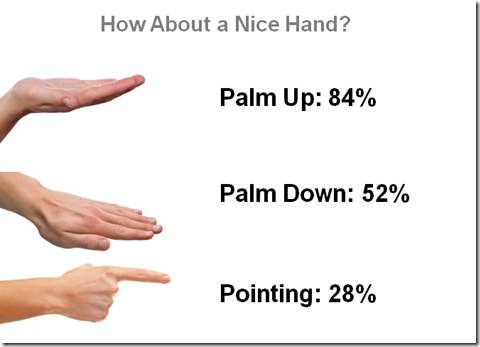Can You Become 56 Percent Better At Presenting–Instantly?
Anyone who’s read a public speaking book or attended a presentation course has likely heard the advice to speak with “open” body language.
Hand gestures are a key part of that advice—and you may be surprised by how much the “little” things matter when it comes to the impression audiences form of you.
Allan and Barbara Pease, authors of The Definitive Book of Body Language, did an interesting experiment. They asked eight lecturers to deliver ten-minute talks to various audiences using three different hand gestures. “We later recorded the attitudes of the participants to each lecturer,” the authors wrote.
Their findings were dramatic.
“We found that the lecturers who mostly used the Palm-Up position received 84 percent positive testimonials from the participants, which dropped to 52 percent when they delivered exactly the same presentation to another audience using mainly the Palm-Down position. The Finger-Pointed position recorded only 28 percent positive audience response and some participants had walked out during the lecture. Finger-pointing not only registered the least amount of positive responses from the listeners; they could also recall less of what the speaker had said.”
That last part is especially striking: Hand gestures not only influenced the audience’s perception of the speaker, but had a direct impact on how much of the speaker’s presentation they remembered.
The Palm-Up position is not only useful during the body of your presentation, but also when taking audience questions. Instead of pointing a finger at an audience member when selecting them to ask a question, use an open palm to indicate that the floor is theirs.
It’s worth noting that there may be better hand gestures in certain situations. For example, speakers wanting to indicate that their stance is non-negotiable may be more effective when using the Palm-Down position. And Joe Navarro, author of What Every Body Is Saying, points out that “steepling” one’s hands is often perceived as a sign of confidence and self-assurance, particularly for women.
Either way, if you tend not to speak using the Palm-Up position, it’s worth experimenting with. No, one study doesn’t give us sufficient data to be able to state that you’ll become 56 percent better just by modifying your hand gestures. But the Pease study is reinforced by many similar body language studies, so it’s not a stretch to believe that you can improve the audience’s perception of you simply by going from being a finger pointer to being a palm-upper.
Want more free public speaking tips? Check out our 25 Most Essential Public Speaking Tips.




What’s an example of using the palm up technique? I’m trying to think how to use it or a point that would be made (other than a Vanna White “here’s an object” type situation). It seems sort of un-natural (at least in the US, and maybe other countries where palm down is considered polite).
Thanks.